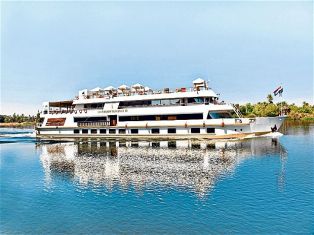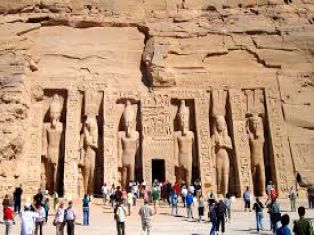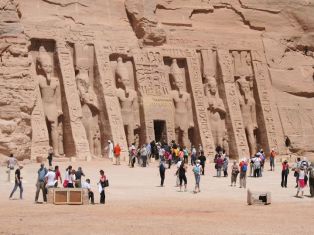Edfu Temple
General Info:-
Edfu is half –way between Luxor and Aswan, its modern name is derived from an ancient one, but it also called (Behdet) the ruins of the ancient city still surround its temple , Horus its chief deity, was surnamed he of (Behdet), and was frequently identified with Horus son of Isis , Hathor the goddess of Dandara was his consort , and Hor-Sma-Tawi ( Horus, uniter of the two lands – harsomtus ) was his son , forming the triad of Edfu. located on the west bank of the Nile , Upper Egypt. The city was known in Greco-Roman times as (Apollonopolis Magna, after the chief god Horus-Apollo. Edfu was one of several temples, built during the Ptolemaic period, including Dendera, Esna, Kom Ombo and Philae. Its size reflects the relative prosperity of the time. In Egyptian mythology Horus of Behdet figures prominently the legend of Horus of Edfu, sometimes called the legend of the winged sun disc, relates that while Ra-Hor-Akhty, the king of the gods , was embarking in Nubia , a revolution broke out against him , he entrusted Horus of Behdet to crush the rebels , Horus defeated then in many battles on the nile , but they reappeared in the form of crocodiles and hippopotami ,he drove them to the eastern boundaries of Egypt and thence to Nubia , where he assumed the form of a winged disc with a uraeus on each side , the enemies being frightened were then no longer able to resist and died outright , Ra-Hor Akhty told Thoth to place this winged disc in every sanctuary where he took rest and in other sanctuaries of the gods of upper and lower Egypt , it became a symbol for defence and triumph to the gods and kings as well . Some scholars see behind this legend real battles of prehistoric or early dynastic times, others maintain that it records the bitter campaigns of the early Egyptians against the crocodiles and hippopotami, the most dangerous monsters to agriculture and civilization, Edfu used to hunt them and some of its priestess harpooned the hippopotami on certain days of the year during the feasts of victory and good union, figures in their form were made of wax or paste and then transfixed. a temple of Edfu must have existed at Edfu in the early dynastic period , it is stated that Imhotep erected a temple there according to a plan which fell from heaven to the north of Memphis, A ruined pylon lies just to the east of the current temple; inscriptional evidence has been found indicating a building program under the New Kingdom rulers Ramses I, Seti I and Ramses II. the temple of Edfu which is standing now dates back to the Ptolemaic era, it is built of sandstone, consider to be the best preserved of all the Egyptian temples , showing the Egyptian temple in its simple design and clear plan , the construction began in 237 BC during the time of Ptolemy Euergetes 1 , the main temple was completed in 212 BC in the reign of Ptolemy Philopatorre, but the decoration of the walls was interrupted as a result of the revolts which broke out in upper Egypt , the great pronaos was built in the time of Ptolemy Euergetes II , the pylon and the girdle wall were annexed in the time of Ptolemy Soter II and Ptolemy alexander I. the decoration of the pylon was accomplished in 57 BC during the reign of Ptolemy Neos Dionysus , the building and decoration of the entire temple took about 180 years including several years of interruption, many generations took part in its construction. Edfu temple is a pure Egyptian temple in its style and reliefs, in which the architects, craftsmen and sculptors strictly adhered to the old Egyptian traditions. The temple of Edfu fell into disuse as a religious monument following Theodosius I's edict banning non-Christian worship within the Roman Empire in 391. As elsewhere, many of the temple's carved reliefs were razed by followers of the Christian faith which came to dominate Egypt. The blackened ceiling of the hypostyle hall, visible today, is believed to be the result of arson intended to destroy religious imagery that was then considered pagan. Over the centuries, the temple became buried to a depth of 12 meters (39 ft) beneath drifting desert sand and layers of river silt deposited by the Nile. Local inhabitants built homes directly over the former temple grounds. Only the upper reaches of the temple pylons were visible by 1798, when the temple was identified by a French expedition. In 1860 Auguste Mariette, a French Egyptologist, began the work of freeing Edfu temple from the sands.
Description of the temple:-
the temple was surrounded by a thick mud-brick wall, parts of which are still standing in ruins to both east and west, in the front stands a great pylon giving access to a spacious forecourt, beyond it is the temple proper, consisting of the great pronaos with the consecration chamber and the temple library within to the south, the hypostyle hall, the hall of the altar, the antechamber and the sanctuary all of which lie on one axis. the inner part is flanked by side-rooms dimly lighted by small apertures in the roofs, with a staircase on each side leading up to the roof of the temple, a numbers of doors connect the parts of the temple together , so that the priests could freely pass from place to place without crossing in front of the sanctuary , the forecourt is flooded with light which gradually diminishes up to the sanctuary , the roof of the temple is provided with lion-headed water-spouts, and around the main temple is a high girdle wall. To the east is an ancient nilometer to which an underground staircase leads from the corridor that surrounding the main temple.
The Pylon:-
Its 79m wide and 35m high, each of the pylons is inscribed with a large scene showing the king smiting a group of kneeling enemies of Egypt in the presence of Horus and Hathor, while on the upper register the king is offering to the triad of Edfu and other different gods, the scenes interrupted by windows, placed to hold the clamps that supported the gigantic flag-poles set inside the niches, then two statues of Horus decorating the entrance to the open court.
The Courtyard:-
The court of offerings surrounded with a colonnade on three sides with different capitals nearly on each column, most of the reliefs carved on the walls and columns are the usual cultic scenes such like the king offering to the gods, purified and crowned before the gods. At the base of side walls at either side of the doorway are reliefs illustrating what is known as the feast of the beautiful meeting between Horus and his wife Hathor. the goddess Hathor used to leave her temple in Dandara in her magnificent bark for Edfu, meanwhile Horus of Behdet sailed to meet her, on arrival at Edfu with their attendants they were received with great pomp and rejoicings, and tambourines were beaten, from every part of upper Egypt, pilgrims used to hasten to Edfu to celebrate the feast, which continued for about 13 days, it was one of the great religious events in the last centuries before Christ in southern Egypt.
**The First Hypostyle Hall:- **
Its supported by 12 columns with different capitals, among the usual offering scenes we find episodes from the foundation ceremonies like stretching the cord, pouring sand, hacking the ground, strewing gypsum, making bricks and erecting the altar inside the sanctuary. there are two small chambers inside the first hall , one on the east which is the library, in which copies of important religious texts were kept, and one on the west side known as the robing room , wherein the chief officiant was rested for the ceremonies to be held in the temple.
The 2nd Hypostyle Hall:-
the inner hypostyle hall having 12 columns, and has a number of side chambers and doorways, the eastern doorway led out to the well , the liquid offerings being kept in the small room off the passage , on the west side we find the laboratory.
The Sanctuary:-
Pass into the most sacred part of the temple crossing the offering hall and the vestibule to enter the sanctuary, two remnants of the ancient furnishing are found inside, first is the low pedestal on which the god's portable barque rested, sometimes joined by the barque of Hathor. Second ancient part is the great granite Naos in which the gods statue lived, dedicated by king Nektanepo II, each morning the high priest would unseal the doors of the shrine (now lost) to reveal the statue during the daily offering rites. A number of chapels surrounding the holy of holies, 10 chapels for different gods like the chamber of the throne of Raa, the chapel of the god Osiris, the chapel of the god Khonso, and directly behind the sanctuary the chapel of the victor, but there is no statue niche set high in the back wall as Dandara. A corridor leads outside the temple where is the most important scenes and inscriptions on the outer wall, which is known as the Sacred Drama which related the age-old conflict between Horus and Seth.
The Mamissi (Birth House):-
It is built along the same lines as the roman Mamissi at Dandara which is modeled after this building; it preserves more of the forward structure, for instance, the colonnade with its low curtain walls between the columns and the curious blend of Pharaonic and foreign motifs in the reliefs. The scene on the walls shows the king presents fields, including a date-palm with fruits.
recommended tours

Private Half - Day Tour: Philae Temple - Unfinished Obelisk & High Dam



